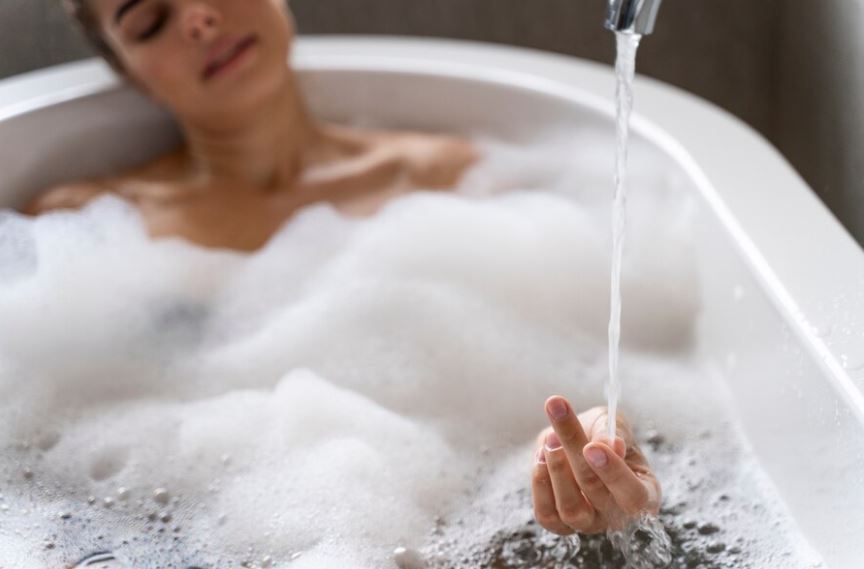How to cut rebar?
April 14, 2018

Ice baths, renowned for their therapeutic benefits, have become a popular recovery method for athletes and fitness enthusiasts. However, ensuring the cleanliness of ice bath water is paramount to safeguarding against potential health risks.
To keep ice bath water clean, prioritize source selection, opting for a reliable and clean water supply. Utilize filtration systems to remove impurities, regularly test and adjust chlorine levels, maintain optimal pH balance, and implement routine draining and refilling. Encourage user hygiene, including pre-bath rinses, clean swimwear, and post-use rinses.
This comprehensive guide will explore practical strategies and best practices to maintain clean and hygienic ice bath water.
Ice baths have gained widespread popularity for their therapeutic benefits in promoting recovery, especially among athletes and fitness enthusiasts. However, maintaining clean ice bath water cannot be overstated. The cleanliness of the water directly influences the effectiveness of the ice bath experience and contributes to the overall well-being of individuals engaging in this recovery method.
Clean ice bath water is paramount for preventing the growth of harmful bacteria and pathogens. Bacterial contamination can lead to skin infections and other health issues, compromising the very purpose of the ice bath.
The primary goal of an ice bath is to provide therapeutic benefits, such as reduced muscle soreness and inflammation. Clean water ensures that these benefits are not counteracted by introducing contaminants that might hinder recovery.
Unclean water increases the risk of infections, skin irritations, and allergic reactions. Maintaining water cleanliness is a preventive measure against these health risks, promoting a safe and hygienic recovery environment.
A clean ice bath contributes to an optimal recovery experience. Users can fully immerse themselves in the therapeutic effects of the cold water without concerns about potential health hazards, fostering a positive and practical recovery session.
Regular cleaning and maintenance of ice bath equipment, including the tub, hoses, and accessories, contribute to their longevity. Clean equipment is less prone to corrosion and damage, ensuring consistent and reliable performance.
Clean ice bath water instils confidence in users. Knowing that the water is free from contaminants and pathogens encourages individuals to fully embrace and benefit from the ice bath experience without reservations about potential health risks.
Maintaining clean ice bath water aligns with health and safety standards. Whether in a professional athletic setting or a fitness facility, adherence to cleanliness standards is essential for compliance and the well-being of users.
Unclean water can develop unpleasant odours due to bacterial growth and impurities. Clean water prevents foul smells, ensuring a more comfortable and pleasant environment for users.

Begin by thoroughly cleaning the ice bathtub, hoses, and any accessories regularly to prevent the accumulation of dirt and bacteria.
Invest in high-quality materials for your ice bath setup to minimize the risk of corrosion, which can introduce impurities into the water.
Water quality management is critical to maintaining clean and hygienic ice bath water. Whether used for therapeutic recovery or sports training, the effectiveness of ice baths is directly linked to the quality of the water. Implementing comprehensive water quality management practices ensures a safe and beneficial experience for individuals engaging in ice bath therapy.
The journey to clean ice bath water begins with selecting an appropriate water source. Choose a reliable and clean water supply to fill the ice bath. Utilizing filtered or purified water from a trusted source minimizes the introduction of contaminants from the outset.
Installing water filtration systems is a proactive step in water quality management. Filtration helps remove impurities, particles, and debris from the water, ensuring the ice bath remains clear and free from potential pollutants.
Regularly test the water for critical parameters such as pH levels, chlorine concentration, and total dissolved solids (TDS). Testing kits are readily available and provide insights into the water's chemical composition, allowing for timely adjustments.
Chlorine or other suitable disinfectants play a crucial role in water quality management. These chemicals help eliminate bacteria and pathogens, preventing their growth in the ice bath water. Carefully follow the recommended guidelines for chlorination to maintain optimal concentrations.
Monitoring and maintaining the pH balance of the water is essential. The recommended pH range for ice bath water is typically between 7.2 and 7.8. An optimal pH level ensures the effectiveness of disinfectants and contributes to water clarity.
Proper temperature control is a vital component of water quality management. Ice bath water should be maintained within the recommended temperature range for therapeutic effectiveness. Regularly check and adjust the water temperature to ensure consistency.
Establish a routine for completely draining and replacing the ice bath water. This practice helps eliminate lingering contaminants and refreshes the water for each use. The frequency of water replacement depends on usage and the overall cleanliness of the water.
Conduct preventive maintenance on ice bath equipment to avoid potential issues compromising water quality. Regularly clean the tub, hoses, and any accessories, and inspect for signs of wear or damage.
Educate users on the importance of maintaining water quality. Please encourage them to adhere to hygiene practices, such as pre-bath rinses and wearing clean swimwear, to minimize the introduction of contaminants.
Maintain records of water quality tests, chlorination levels, and any adjustments made. Documentation helps track trends, identify potential issues, and ensure that water quality management practices are consistently followed.
Maintaining user hygiene is crucial to ensuring the cleanliness and effectiveness of ice baths. Incorporating thoughtful guidelines promotes a sanitary environment and contributes to the overall well-being of individuals engaging in this therapeutic recovery method.
Encourage users to rinse off thoroughly before entering the ice bath. This helps remove oils, lotions, and contaminants from the skin, preventing these substances from entering the water.
Advocate for the use of clean swimwear when entering the ice bath. This helps minimize the introduction of foreign materials and ensures a more hygienic bathing experience.
Encourage users to take a quick shower before using the ice bath. A brief rinse helps further eliminate residual substances on the body, contributing to cleaner water.
Advise users to avoid using perfumes, cosmetics, or heavily scented products before entering the ice bath. Strong fragrances can potentially interfere with water quality.
If users have long hair, recommend securing it with a hair tie or cap. This prevents hair from entering the water, reducing the risk of clogs and maintaining water clarity.
Remind users to keep personal items like watches, jewellery, or accessories out of the ice bath. These items can introduce contaminants and affect water quality. It would help if you also read How to cut rebar?
Educate users on the importance of not using the ice bath if they have open wounds, cuts, or contagious skin conditions. This precautionary measure helps prevent the spread of infections.
Encourage responsible use of the ice bath by all users. Reinforce the understanding that maintaining cleanliness is a shared responsibility, ensuring a positive experience for everyone.
Suggest a quick rinse after exiting the ice bath. This helps remove any residual cold water and promotes a seamless transition to average body temperature.
Provide information and signage outlining user hygiene guidelines. Education is critical to fostering awareness and encouraging users to contribute to the ice bath environment's cleanliness actively.
By incorporating these user hygiene guidelines, individuals can collectively contribute to a cleaner and more hygienic ice bath experience. These practices ensure water quality and promote a positive and comfortable environment for everyone engaging in ice bath therapy.
Maintain the recommended temperature for the ice bath water. Lower temperatures can slow bacterial growth, but icy water may pose risks.
Use a reliable thermometer to monitor the water temperature regularly, making adjustments to ensure consistency.
Ensuring the longevity and effectiveness of ice baths relies heavily on a consistent and thorough inspection and cleaning routine. Regular maintenance practices contribute to a hygienic environment and prevent potential issues that could compromise the integrity of the ice bath and water quality.
Conducting regular visual inspections is the first line of defence against potential problems. Look for signs of algae growth, discolouration, or foreign particles in the water. Inspect the ice bathtub, hoses, and accessories for wear, tear, or damage.
Scrub the ice bathtub thoroughly using a mild detergent or specialized cleaning solution. Pay attention to corners, crevices, and areas where contaminants accumulate. Rinse the tub thoroughly to remove any residual cleaning agents.
Inspect hoses and accessories for any signs of blockages, leaks, or wear. Ensure the hoses are securely attached, and promptly replace any damaged components. The proper functioning of hoses is crucial for maintaining water circulation.
Implement a regular disinfection routine using chlorine or other recommended disinfectants. Follow guidelines for safe application and adjust the disinfectant levels based on regular water testing. Disinfection helps prevent bacterial growth and ensures water sanitation.
Establish a routine for draining and refilling the ice bath water. Draining the water entirely allows for a fresh start, eliminating residual contaminants that might accumulate over time. This practice should be conducted at regular intervals, depending on usage.
If your ice bath has a cover, inspect it for cleanliness and integrity. A body helps prevent debris, dust, and potential contaminants from entering the water when not in use. Clean the cover regularly and replace it if damaged.
Maintain a record of each inspection and cleaning session. Document any issues discovered, actions taken, and water quality or equipment adjustments. This record-keeping practice provides valuable insights into the ice bath's overall condition.
Consider periodic professional maintenance to ensure a comprehensive assessment of the ice bath. Professionals can conduct more in-depth inspections, address potential issues, and guide on optimizing performance.
Maintaining clean ice bath water is pivotal for optimizing the therapeutic benefits of this popular recovery method. Through a combination of meticulous water quality management, regular inspections, and a disciplined cleaning routine, individuals can ensure a hygienic and safe environment. From selecting a clean water source to implementing disinfection measures, every step contributes to ice baths' overall effectiveness and longevity. By prioritizing cleanliness, users can confidently immerse themselves in a rejuvenating experience, reaping the rewards of reduced muscle soreness, inflammation, and enhanced recovery. A commitment to these practices fosters a positive and beneficial ice bath experience.
Add 1 to 2 cups of hydrogen peroxide per 100 gallons of ice bath water. This concentration helps to disinfect the water, preventing bacterial growth. Regularly test and adjust the hydrogen peroxide levels based on the size of your ice bath to maintain optimal cleanliness and safety.
Clean ice bath water prevents the growth of harmful bacteria and contaminants, ensuring a safe and effective recovery experience.
Yes, using chlorine or other disinfectants at recommended levels is essential to kill bacteria and maintain water sanitation. Regularly test and adjust chemical levels.
Monitor and maintain the pH balance within the recommended range to ensure the effectiveness of disinfectants. A pH level between 7.2 and 7.8 is generally suitable.
Encourage users to rinse off oils, lotions, and contaminants before entering the ice bath. Wearing clean swimwear also helps prevent the introduction of foreign materials.
Maintain the recommended temperature for ice bath water. While lower temperatures can slow bacterial growth, icy water may pose risks. Regularly check and adjust the temperature as needed.
Conduct visual inspections regularly, looking for signs of algae, discolouration, or foreign particles. Implement a thorough cleaning routine every 1-2 weeks for all components.
It's recommended to use commercial cleaning solutions designed for fitness equipment and water systems. Homemade solutions may not provide the necessary level of sanitation.
Comments
Write a comment